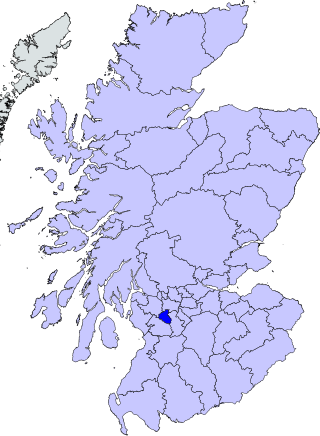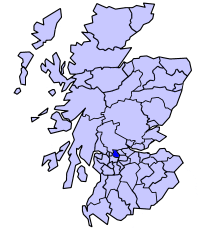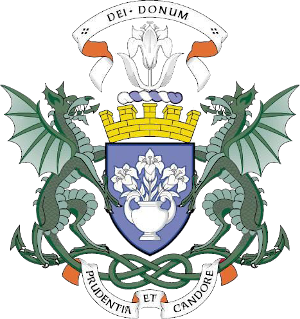1994 to present
| | This section needs expansion. You can help by adding to it. (March 2009) |
Local government areas covering the whole of Scotland were first defined by the Local Government (Scotland) Act 1889. As currently defined, they are a result, for the most part, of the Local Government etc (Scotland) Act 1994.
The 1889 Act created a country-wide system of local government based on pre-existing counties and burghs. Prior to this act burghs had their own elected local government councils but counties did not.
The county and burgh system was abolished by the Local Government (Scotland) Act 1973 and replaced by a system of regions and districts and single-tier islands council areas.
The 1994 Act abolished the regions and districts and replaced them with a new system entirely composed of single-tier authorities; the Orkney, Shetland and Western Isles councils were continued by s.3 of the Act in substantially unchanged form.
Over this period local government in Scotland was based on three units: counties, burghs and parishes.
The Local Government (Scotland) Act 1889 reformed the administration of counties and also made alterations to their number and boundaries: Ross-shire and Cromartyshire were combined to form Ross and Cromarty; the Lower, Middle and Upper Wards of the County of Lanark, which formed separate counties for some purposes, were merged; and Orkney and Zetland were divided into distinct counties. A boundary commission was appointed, and between 1891 and 1892 many anomalies in county boundaries were rectified. [1] In 1890 each of thirty-three counties was given a county council, partly elected, and partly co-opted by the town councils of burghs in the county. In effect the county council only exercised full powers in the "landward" areas of the county, outside of burgh boundaries.
County councils were required to divide their county into districts, each of which was under the supervision of a district committee with powers and duties independent of the county council in regard to highways and public health.
The district committee was composed of the county councillors elected for the area along with one representative from the parochial board of each parish in the district. Burgh councils could transfer the maintenance of the highways and bridges of the town to the county council, whereupon a representative of the burgh was appointed to the committee. In counties with fewer than six parishes, the county council was not obliged to form districts. [1]
Burghs were a form of town government dating back to the twelfth century. Originally created by charter, and mainly concerned with trading privileges, they had been reformed earlier in the nineteenth century. Legislation enacted in 1833 allowed the inhabitants of existing burghs to adopt a "police system" allowing for the paving, lighting, cleansing, watching, supplying with water, and improving of the town. [2] A further act of 1850 could be adopted by any place with a population of 700 which thereupon became a "police burgh". [3] Those burghs which had not adopted a police system were abolished in 1893. [4] Burghs were largely autonomous, and when county councils were established they had a limited jurisdiction within burgh boundaries.
The royal burgh of Edinburgh was, by virtue of various charters, a "county and city" and entirely outside the jurisdiction of Midlothian County Council. [5] In 1893 Glasgow became a county of a city by private act of parliament [6] [7] Dundee followed in 1894 and Aberdeen in 1899. [8] [9]
The lowest tier of local government was the parish. Parochial boards had been established in 1845 for the administration of poor law, and, outside burghs, had gradually acquired various public health duties. In 1894 they were replaced with elected parish councils. [10]
In 1919 Scotland was divided into education areas. These consisted of the four counties of cities, the burgh of Leith and each of the local government counties. In the case of the counties, they were to include "every burgh situated therein". The education authorities were elected under proportional representation, and unlike the county councils, all members were directly elected. [11]
By 1928 Scotland had 1,298 different local authorities, many of them overlapping. [12] In November the Scottish Office issued a bill to reform local government: this sought to abolish 1,064 of the various bodies, leaving only 33 county councils and 201 burgh councils. [13] Burghs (other than the counties of cities) were to be divided into two classes: large burghs and small burghs. Large burghs were to gain considerable powers from the county councils. Small burghs, conversely, were to cede most of their duties to the county councils. [13]
The original bill was altered in the course of passage through parliament. In response to protests that the abolition of both parish councils and district committees left a gap in the system, the landward part of each county was to be divided into districts, governed by councils consisting partly of the county councillors for the area and partly of elected district councillors. [12] The final act also provided for the combination of a number of neighbouring small burghs, and paired Kinross-shire and Perthshire and Nairnshire and Moray into "combined counties". The individual counties and county councils continued to exist in these areas, but a joint county council became the principal local authority. [14]
Following the changes, which came into effect in 1930, the following were the local government areas into which Scotland was divided: [14]
This system was restated in the consolidating Local Government (Scotland) Act 1947. The number of small burghs increased and the number of districts declined over the time period. Neither the 1929 or 1947 legislation contained a procedure by which a small burgh could become a large burgh on reaching sufficient population. Accordingly, only one new large burgh was formed at East Kilbride, which required the passing of a local act of parliament in 1967. [15]
The Local Government (Scotland) Act 1973 created a system of nine two-tier regions and three single-tier islands council areas, and this system completely replaced local government counties and burghs in 1975.
Each two-tier region had a regional council and of a number of district subdivisions, each with its own district council. The number of districts in each region varied from three to 19.
The 1973 Act was based closely on proposals in the Wheatley Report, produced by a Royal Commission into Scottish local government in 1969. The new regions and districts were generally very different from the counties and districts which they replaced.
Two of the new islands council areas had the boundaries of former counties. The third consisted of an area formerly divided between two counties.
| | This section needs expansion. You can help by adding to it. (March 2009) |

Falkirk is one of 32 unitary authority council areas of Scotland. It was formed on 1 April 1996 by way of the Local Government etc. (Scotland) Act 1994 from the exact boundaries of Falkirk District, one of three parts of the Central region created in 1975, which was abolished at that time. Prior to the 1975 reorganisation, the majority of the council area was part of the historic county of Stirlingshire, and a small part, namely Bo'ness and Blackness, was part of the former county of West Lothian.

Dunbartonshire or the County of Dumbarton is a historic county, lieutenancy area and registration county in the west central Lowlands of Scotland lying to the north of the River Clyde. Dunbartonshire borders Perthshire to the north, Stirlingshire to the east, Lanarkshire and Renfrewshire to the south, and Argyllshire to the west.

For local government purposes, Scotland is divided into 32 areas designated as "council areas", which are all governed by single-tier authorities designated as "councils". They have the option under the Local Government (Scotland) Act 1997 of being known as a "comhairle" when opting for a Gaelic name; only Comhairle nan Eilean Siar has chosen this option, whereas the Highland Council has adopted its Gaelic form alongside its English equivalent, informally.

Stirlingshire or the County of Stirling is a historic county and registration county of Scotland. Its county town is Stirling.

Ettrick and Lauderdale was one of four local government districts in the Borders region of Scotland as well as a lieutenancy area from 1975 to 1996.

Eastwood was a local government district in the Strathclyde region. It was derived from the civil parish of Eastwood which had been within the county of Renfrewshire, though latterly included areas which had become annexed Lanarkshire and the expanding city of Glasgow. Established in 1975, it covered the parts of the parish outside Glasgow, plus adjoining areas to the south; it was abolished in 1996 to become part of East Renfrewshire.

Strathkelvin is the strath (valley) of the River Kelvin in west central Scotland, lying north-east of Glasgow. The name Strathkelvin was used between 1975 and 1996 for one of nineteen local government districts in the Strathclyde region.
A county council is the elected administrative body governing an area known as a county. This term has slightly different meanings in different countries.
The local government areas of Scotland were redefined by the Local Government (Scotland) Act 1973 and redefined again by the Local Government etc (Scotland) Act 1994.

The Representation of the People Act 1948 was an Act of the Parliament of the United Kingdom that altered the law relating to parliamentary and local elections. It is noteworthy for abolishing plural voting for parliamentary elections, including by the abolition of the twelve separate university constituencies; and for again increasing the number of members overall, in this case to 613.

Renfrew District was, between 1975 and 1996, one of nineteen local government districts in the Strathclyde region of Scotland.

The Local Government (Scotland) Act 1889 is an Act of the Parliament of the United Kingdom which was passed on 26 August 1889. The main effect of the act was to establish elected county councils in Scotland. In this it followed the pattern introduced in England and Wales by the Local Government Act 1888.

Renfrewshire or the County of Renfrew is a historic county, registration county and lieutenancy area in the west central Lowlands of Scotland. The lieutenancy area covers the three modern council areas of Inverclyde, Renfrewshire and East Renfrewshire, and this area is occasionally termed Greater Renfrewshire to distinguish it from the modern council area called Renfrewshire. The historic county additionally included territory on the south-western edge of Glasgow which was gradually transferred to the administrative area of the city as it grew.

The Local Government (Scotland) Act 1929 reorganised local government in Scotland from 1930, introducing joint county councils, large and small burghs and district councils. The Act also abolished the Scottish poor law system with institutions passing to the local authorities.

The Local Government (Scotland) Act 1947 is an Act of the Parliament of the United Kingdom, that reformed local government in Scotland, on 1 October 1947.

Scottish Westminster constituencies were Scottish constituencies of the House of Commons of the Parliament of Great Britain, normally at the Palace of Westminster, from 1708 to 1801, and have been constituencies of the House of Commons of the Parliament of the United Kingdom, also at Westminster, since 1801. Constituency boundaries have changed on various occasions, and are now subject to both periodical and ad hoc reviews of the Boundary Commission for Scotland.

Dundee City Council is the local government authority for the Dundee City council area. It was created in 1996 under the Local Government etc. (Scotland) Act 1994.

Clydebank was, from 1975 to 1996, one of nineteen local government districts in the Strathclyde region of Scotland, covering the town of Clydebank and adjoining areas to the north-west of the city of Glasgow.
Civil parishes are small divisions used for statistical purposes and formerly for local government in Scotland.